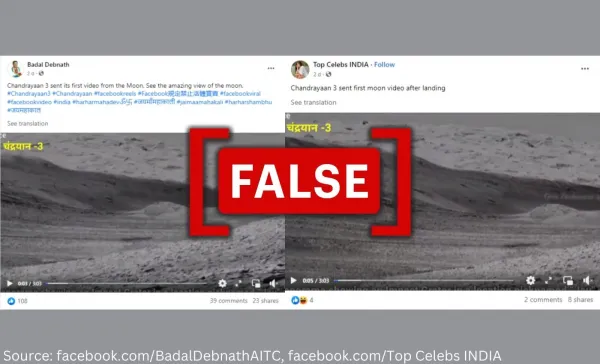By: Rahul Adhikari
August 29 2023

The video was created by zooming in on a 360-degree image of Mars' surface captured by NASA's Curiosity Mars rover.
India became the fourth nation to achieve a lunar landing when Chandrayaan-3, Indian Space Research Organization’s (ISRO) third lunar mission, successfully soft-landed on the moon on August 23. ISRO’s feat was celebrated by millions of Indians glued to their television sets to witness the touchdown.
What is the claim?
Against this backdrop, several users have shared unrelated footage linking them to the space mission. One such video is being widely shared on Facebook, claiming that Chandrayaan-3 sent its first video from the moon. The viral three-minute-long black-and-white video shows a rocky surface claimed to be that of the moon. The caption of one post with the video read, “Chandrayaan 3 sent its first video from the Moon. See the amazing view of the moon.” Several other users have posted the same video on Facebook with the same claim. An archived version of the post can be found here.
The posts as seen on Facebook (Source: Facebook/Altered by Logically Facts)
However, the claim is false. The video was created by zooming in on a 360-degree image of Mars captured by NASA's Curiosity Mars rover.
What did we find?
We reviewed the viral video carefully and noticed some text running at the bottom of the video. One sentence from this text read, “The scene was captured with Curiosity Rover’s...” At the end of the video, the text read, “Latest 4K resolutions most fascinating panoramic scene from NASA’s Mars rover took this 360-degree panorama while atop ‘Mont Mercou.’” We also noticed a logo in the top-left corner that read ‘TT Space,’ with the first T written upside down.
Taking a cue from this, we found an extended version of the same video was shared by the YouTube channel ‘Tavi Technical Space’ on August 8. The title of the eight-minute-long video in color read, "Mars Rover's Panoramic Cam Captures Latest 360° Unexpected Weird 4K Video Footage of Mars Life." The description of the video further explained that the video showed “360-degree real panorama images in 4k resolutions from Mars taken by onboard Mast cameras”.
We compared the viral clip with this version and found that the former has been cropped out of the YouTube video. The viral clip begins from the 0:28 timestamp of this video and runs till 4:12. A few shots were removed from the source video before being shared online as actual footage sent from Chandrayaan-3.
We noticed an oval-shaped crater and similar rock structures in both videos. The exact same text was also running in both videos with the same frame in the background. The YouTube channel credited U.S. space agency National Aeronautics and Space Administration (NASA) for the video.
Image comparison between the viral video and the YouTube video. (Source: Facebook/YouTube/Altered by Logically Facts)
Further research revealed that the video was created by zooming in on different portions of a 360-degree image of Mars captured by NASA's rover Curiosity. The video ultra-zooms on small objects within the image, and the creator of the video raises some questions in the text that appear at the bottom of the video. As seen in the photos above, the creator of the video questions whether the crater on the surface might have once been an ancient pond or what the mysteries behind the rock structures are.
The Curiosity rover is a robotic spacecraft constructed by NASA's Jet Propulsion Laboratory, managed by Caltech in Pasadena, California. We located the image on NASA’s Jet Propulsion Laboratory website.
The image displays an impact crater on Mars nicknamed "Jau," which was captured using the rover's Mastcam on July 25, 2023, the 3,899th Martian day, or sol, of the mission. The image was published on August 3, 2023. We compared the YouTube with the 360-degree image and spotted the same crater and rock surfaces in all the visuals. Therefore, we concluded that the YouTube video was created by zooming in on the image.
A comparison between the YouTube video and NASA's image. (Source: YouTube/NASA/Altered by Logically Facts)
We spotted identical structures in both visuals— a larger black-colored rock-like object and a smaller brown-colored structure. At the 3:37 timestamp, an editing layer has been applied to the small brown structure in the YouTube video, shaping it into an idol of the Hindu god Ganesha. The creator of the YouTube video uses an editing layer that very obviously appears and fades away within six seconds of being added and states, “A similar statue of the Hindu god Ganesha.”
The YouTube videoapplies an editing layer to NASA's image. (Source: YouTube/NASA/Altered by Logically Facts)
Further, we could not find any such video shared by ISRO, which has been releasing official visuals of the lunar mission. The space agency has so far only released a video that shows Chandryaan-3’s rover Pragyan on the moon. In another tweet, ISRO has also shared two images – one displaying a crater on the moon and the other showing the rover's path.
The verdict
The claim that the viral video shows the first video of the moon captured by the Chandrayaan-3 spacecraft is false. The video has been created by zooming in on a 360-degree image captured by NASA's Curiosity Mars rover. The image was captured on July 25 and published on August 3, well before Chandrayaan-3 landed on the moon.